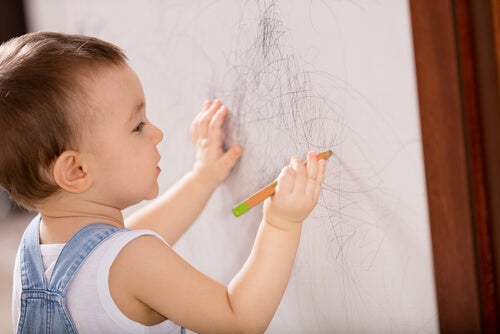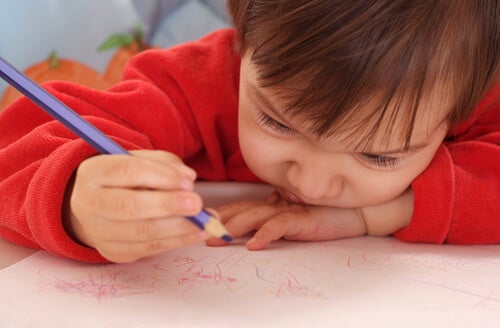Scribbling: The Secret Language of Children

Children amaze us with their creativity. Since they have no internalized standard way of communicating, they can be very inventive with this in the context of social interaction. One way they do this is by scribbling. Scribbling here refers to markings with a particular and concrete meaning. However, scribbling may be more than just mindless markings and may represent a form of communication.
As children get older, their ways of communicating become more structured. As this happens, scribbling transforms into drawings, words, phrases, and stories as their new tools for communication.
In this article, we’ll show you what children’s scribbling means. You’ll see that this is a sort of secret language. You’ll also learn some other things about this world of expression.
Scribbling: What is it?
Scribbling refers to creative markings that tend to become more complex as a child gets older. In the beginning, it can seem disordered and impulsive. That’s because the infant hasn’t developed fine motor skills. Nevertheless, every marking does hold some significance. We would understand that if the child could explain what they have scribbled out or if we had the resources to interpret it.
Together, the markings might follow a specific theme. You might be able to see the following reflected in them:
- Emotions
- Desires
- Fears
- The child’s stage of development
- The biological rhythms of the child

So we’re talking about a form of communication. That’s why psychologists and psychiatrists interpret scribbles in their work. In other words, they use these as instruments to analyze the child’s problems. These could be biological, as they reflect the child’s stage of development. On the other hand, they could be psychological, as they allow the child to express their internal world. Scribbling is essentially made up of two components:
- The act. This includes the manifestation of intention, the spontaneity, or the intent to transmit a message.
- The markings. These show the level of mastery the child has. That is to say, the level of ease or difficulty with which the child creates the drawings.
Thus, scribbling is related to sensory and motor aspects. The first reflects what the child perceives as well as the stimuli that they’re sensitive to. As for the second, the motor element is what allows them to act on their external world.
The secret language of children
Scribbling is a type of language. That’s because it’s a way in which children express themselves. Even though this is a very basic act, it can be charged with emotion. With this, we mean that scribbles are manifestations with which the child lays down communication bridges with others. This is especially important as they may not know how to communicate with words or may prefer not to do so.
As lecturer and psychologist Evi Crotti and physician Alberto Magni, who specializes in psychotherapy and psychosomatic illnesses, suggest in their book Scribbling: The Secret Language of Children, “the act of scribbling on a piece of paper makes communication between child and adult possible” (pg. 19).
Language can take on different forms. One dictionary definition is “the ability of a human being to express and communicate with others through articulated sounds or other signaling systems”. Based on this, you can see that this isn’t just about speech. It also includes writing, nonverbal communication, and symbols. As such, there’s room within the realm of language for scribbling, as it’s also a form of expression. It’s a way for children to tell us something about their internal world.
Interpreting scribbling
In order to be able to interpret scribbling, you have to take two fundamental aspects into account:
- The maturity of the nervous system. Specifically, we mean its maturation in terms of representative capabilities. It’s characterized by well-defined foundations: motor skills, space, symbolic function, and language, among others.
- The fact that not everyone is qualified to interpret them. You need to be aware that, even though there are some parameters that indicate certain things, the only people who are capable of and authorized to legally interpret this type of material correctly are the professionals. These are psychologists, psychology professors, and psychiatrists. This, of course, depends on the legislation in your particular country.

In the following section, we’re going to show you some interpretation patterns. However, you should remember that every child is unique. A few descriptions that we present here aren’t enough to get a complete and integrated interpretation of an individual child’s scribbling. These are merely typical interpretations that might help you if you feel or discover that something is happening. In any case, don’t hesitate to go to a professional if you think it’s necessary.
A list of characteristics
It’s important to pay close attention to details in order to be able to interpret children’s scribbles. Keep the following in mind:
- The manner in which they do it. Pay attention to how the child holds the pencil in their hand. Are they calm and free or do they show some kind of tension?
- Starting point. When the child starts the drawing in the center of the page, this tends to mean that they know their place in the external world. When they don’t, this could indicate shyness or tension.
- Space. If they take up a lot of space with their scribbling, this indicates confidence, extroversion, and a desire for growth. When they use up only a little space, this could mean that the child is afraid, inhibited, or introverted.
- Pressure. When a child scribbles lightly and indistinctly, this could mean they’re of a sensitive nature. Darker lines can mean a great amount of energy and a need for more personal space.
- The strokes. If they’re confident, this could reflect ease with the activity. If not, it could indicate some fear. Alternatively, timid scribbling could come as a result of a strict upbringing.
- The shape. Every circle, line, curve, angle, broken line, or other shape is a reflection of where the child places themselves in the world. In other words, this is how the child perceives themselves and how they develop.
- Circles. The projection of the image most familiar to a child – the face.
- Angles. Indicate tension and resistance.
- Scribbling with pointed strokes. These are signals of an intense emotional life. They can also be a cry for more contact due to some worry.
- Broken lines. May point to a fear of separation from the objects of their affection.
The meaning of colors
Colors can also hold meaning. They can reveal traces of aggression, joy, love, etc. The psychology of color tries to categorize these possible meanings. For example, red could be representative of impulsivity, yellow of joy, black of fear, sadness, or aggression, and white of tranquility.
Scribbling can be a window into a child’s internal world. Paying attention to these scribbles can help you know how they’re feeling. This is really a marvelous language that becomes more and more elaborate as time goes by. However, even though it’s “secret” because we don’t understand it at the beginning, we can come to discover meanings in it. That way we also come to be more aware of the child’s personality and also what’s happening in their life.
All cited sources were thoroughly reviewed by our team to ensure their quality, reliability, currency, and validity. The bibliography of this article was considered reliable and of academic or scientific accuracy.
- Crotti, E, & Magni Alberto. Garabatos: el lenguaje secreto de los niños. Málaga España, Sirio.
This text is provided for informational purposes only and does not replace consultation with a professional. If in doubt, consult your specialist.








